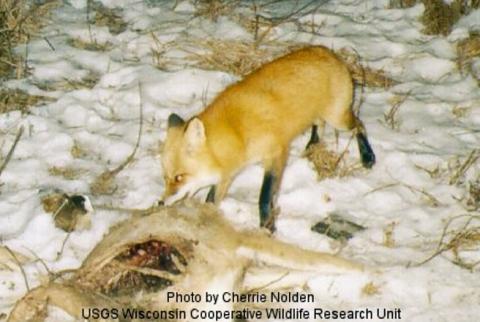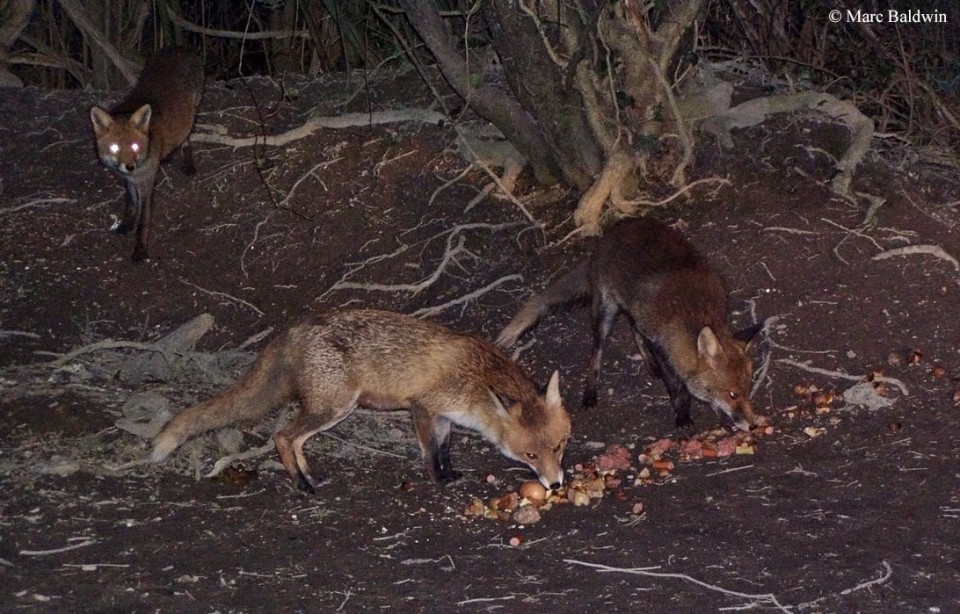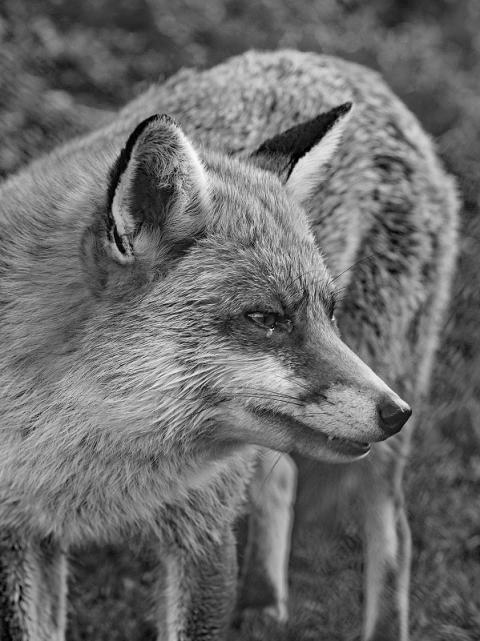Red Fox Diet - Scavenging
Foxes are not averse to taking carrion and where they share their territory with larger carnivores (lynx and wolves, for example), they may shift their diet more towards scavenging from their kills. They will also make use of any animals killed on roads or by hunters. Indeed, following 641 miles of fox trails on three study areas in Michigan, USA, during two winters, led wildlife biologist Ray Schofield to 61% of the deer carcasses marked (i.e., shot, but not collected) during the hunting season. In their Mammals of the Soviet Union, Vladimir Heptner and Nikolaï Naoumov noted that foxes feed on carrion only in the late hours of the evening and overnight, leaving at sunrise (often to lay up nearby, where it may remain for several days, visiting the carcass periodically) -- if the carrion is visited by wolves the fox, according to Heptner and Naoumov, follows after them early in the morning.
A carcass may occasionally attract several foxes that will feed together; it is unclear whether such aggregations of an ordinarily territorial species consist of related individuals, although some reports suggest not. In his book, British Wild Animals, for example, Mortimer Batten described "a dozen foxes" surrounding a dead stag killed by the harsh conditions in the Highlands during the memorable winter of 1947. Batten wrote:
"One or two of them were lying down, tidying themselves or gnawing the ice from between their toes. Others were bickering, and their yaps and yells sounded strange in a silence which seemed veritably to hiss. One was rolling in the snow in the centre of the frozen burn, and others were gnawing lazily at the stag. They had clearly eaten their fill..."

In the Highlands of Scotland, foxes typically live singly or in pairs, so a group of 12 would indicate multiple neighbouring animals making use of this food resource.
A recent study by Rebekah Ruzicka and Michael Conover at the Utah State University in the USA suggests that the weather conditions and the landscape in which a carcass is lying impact how easily a scavenger can track it down. The reason for this is that wind speeds above about three metres per second (6 knots) causes air mixing and turbulence, which dilutes odours, making them more difficult to follow. Indeed, it has been calculated that ideal scavenging conditions occur at wind speeds of between one and four meters per second (2-8 knots), with cool, humid conditions to allow the scents to linger in the air and on the ground. By contrast, hot, dry conditions cause scents to be quickly vapourised and dispersed within a few minutes.
In a paper to the journal Ethology in 2012, Ruzicka and Conover presented data from their study in which they distributed chicken eggs and dead starlings in various different habitat types around the Willard Bay Reservoir between May and August 2009. The researchers found that 66 eggs and 87 starlings were eaten by raccoons, foxes and skunks; the baits hung around for longer as wind speeds increased and they concluded that:
"... red foxes, striped skunks , and raccoons were better able to find bait when it was cool and humid, presumably because such conditions cause scents to linger."
Foxes will occasionally scavenge carcasses of their own species. Some authors have suggested that this happens during particularly harsh winters, although Stephen Harris observed cannibalism in the relatively food-rich habitat of suburban London (fox remains in six stomachs, accounting for 0.6% of the total diet), as did Brian Coman in Victoria, Australia (fox remains in 27 stomachs, accounting for just under 3% of the diet).
Roger Burrows described how foxes excavated and removed the bodies of foxes and badgers buried in his garden, in one case removing the head of a dead fox, although this should be treated with caution. I have heard similar accounts of foxes digging up the bodies of foxes buried in people's gardens, which has led to the suggestion that foxes may bury their dead (i.e., remove the bodies from the garden and re-bury them elsewhere) -- this seems unlikely and scavenging is a more probable explanation. Infanticide (the killing of young of your own species) is a relatively well-known phenomenon among foxes (see infanticide QA), but there is no evidence, that I know of, to suggest adult foxes actively hunt and kill each other for food. Similarly, European badger (M. meles) remains sometimes appear in fox scats and stomachs, but do not constitute significant dietary components and are invariably scavenged.

Foxes are well known to scavenge in urban areas, where they will consume human refuse but, even in rural areas, scavenging human waste is well documented. In rural Japan, for example, Paolo Cavallini found that foxes spent between 20% and 50% of their time active around the houses of nearby villages, moving quickly from village to village -- some 50% of their diet was of human origin. Indeed, the percentage of human-derived food in the diet varies considerably according to region and season, from nothing (or only a few percent) among foxes in very remote regions, to 80% or more among foxes living in large cities.
A study by Stephen Harris, published in Mammal Review during 1981, looked at scavenged items found in the stomachs of 571 foxes caught in London, finding that meat and bones from joints and carcasses composed 18.4% of the diets. Interestingly, Harris found that 34% of the diet was composed of wild birds and mammals (mainly voles, squirrels and blackbirds), so even in the city foxes were hunting normal wild prey. Bread, dried fruit and potato peelings were also present, representing 3.1%, 2.4% and 1.6% of the diet respectively.
A similar study, this time by a team led by Patrick Doncaster and published in the Journal of Mammalogy during 1990, looked at the feeding ecology of foxes in Oxford (UK) and found a higher percentage (about 60%) of scavenged items in their diets. Interestingly, Doncaster and his co-workers found that, at some sites where food was provided by residents, scavenging foxes were highly selective, discarding some edible items in preference for others.
Harris and Doncaster both reported that no single species or category was dominant in the diets of these "city slickers". Working in the Trans-Himalayan mountains of India between February and March 2011, a team at the Nature Conservation Foundation in Karnataka led by Abhishek Ghoshal studied the response of fox diet to increasing human habitation in the region. Their results, published in the European Journal of Wildlife Research in 2016, show "anthropogenic items" (mainly garbage) occurring in almost 84% of the 225 fox scats they analysed, while "wild food" in the form of insects, small mammals, wild herbivores and birds occurred in 38% of the droppings.

A study of foxes living in the Swiss city of Zurich was published in Mammalian Biology during 2004 by a team at the University of Zurich, and reported on the contents of 212 fox stomachs, finding similar values to Doncaster and his team, although with some dominance of food types observed.
The researchers found that scavenge (primarily scavenged meat) and cultivated crops (especially apples, plums and cherries) were the primary components of the diet, comprising nearly 62% of stomach contents -- furthermore, almost 60% of the stomachs examined mainly or exclusively contained one of these items. Rodents and birds were also present, occurring in 26% and 24% of stomachs, respectively. Insects (17.5% of stomachs), pets or domestic stock (10.4%), pet food (6.1%) and bird seed (9.4% - found from January to March only), were also found. Even in the 'urban zone' of the study, "natural food" (namely birds and wild mammals) still contributed 20% of the foxes' diet. Furthermore, the biologists didn't see foxes exploit bin liners regularly or systematically, suggesting that they were opting for less exposed food sources.
Some studies of urban fox diet have recorded inedible items, such as food packaging (e.g., aluminium foil, plastic, and paper) in the diet. One study in California's Orange County during the early 1990s found the remains of human food and food packaging in 42% of fox scats recovered during the spring, rising to 86% during the winter; unfortunately, the authors don't split out the two categories, so we don't know how much of this percentage was the packaging and how much was the food it contained.
In urban areas, foxes are also known to raid dustbins for scraps and even take more unexpected nourishment. In 2020, for example, BBC NHU developer Gavin Boyland filmed a dog fox in Bristol carefully peeling the foil lids of milk bottles to lap at the cream on the top. Dustbin-raiding (and probably milk theft) appears to occur much less frequently than many people realise and much of a fox's diet is deliberately supplied by householders; many people gaining considerable pleasure from feeding their local foxes. Indeed, one survey in Bristol found that 10% of households were putting out food for foxes every night during the early 1990s. How likely a resident was to put food out depended, however, on how often they saw the foxes -- the more often the householders saw foxes, the more often they put (and often the greater the quantity of) food out. It would be interesting to know whether the recent economic recession across much of Europe has impacted the amount of food available to wildlife.

Recently, an intriguing study of fox droppings collected in Scotland's Cairngorm National Park by Aberdeen University biologist Cristian Waggershauser and colleagues suggested that dog faeces may also represent an important calorie resource. The data, published in Ecology and Evolution during 2022, show traces of domestic dog DNA were found in 39% of the 647 droppings analysed and the authors suggest their findings point to interspecific coprophagia (i.e., the foxes are eating dog faeces). Indeed, when they looked at the energy content of dog faeces, they were found, on average, to contain 135 kcal per 100 grams wet weight. In keeping with their flexibility, when looking only at the droppings collected in winter, when field voles are scarce, 48.5% of scats contained dog DNA, suggesting that this energy source is seasonally important. We don't know whether urban foxes routinely take dog faeces in urban environments, but there must be ample opportunity in many British towns and cities, and in March 2024 a post mortem of a vixen found collapsed in Surrey revealed a tangled mass of dog poo bags in its digestive tract.
So, from the above, we can see that the widely held notion that foxes in our towns and cities survive solely by raiding our bins, or picking up the food dropped by revellers every Friday and Saturday night, is inaccurate. Even in the middle of our large towns and cities, foxes are still hunting birds, mammals, amphibians and insects, despite not apparently having to. Indeed, Harris and his team have demonstrated that, in Bristol, so much food was deliberately supplied (either specifically for them, or in the form of bird food, pet food, or compost heaps in which to search for scraps and insects), that the foxes could survive without hunting or raiding bins at all -- one survey found that, in each territory, nearly three-times the amount of food required by a single fox was being put out every week (see How much food?).
Recently, there has been some suggestion that urban foxes are evolving a different skull structure to rural animals possibly as a result of muscular rearrangement to accommodate increased scavenging: the skulls appear shorter and wider, with smaller jaws and a longer sagittal crest but smaller zygomatic arches and brain case. An increase in skull size in parts of Europe over the last century has also been documented, although this is associated with the availability of large prey species (gamebirds, hares, etc.) thanks to human intervention, rather than a result of scavenging. Moreover, as we have covered, even in urban areas foxes are still actively hunting other animals.
The foxes seen in our towns and cities are, however, often in palpably poor condition and I do wonder whether the urban environment allows a fox to eke out an existence that might not be possible in the countryside. It certainly seems to be the case that food availability in urban areas is less seasonal than in more rural locations, making it more reliable and introducing the possibility that urban animals could live longer, grow larger, extend their range further and breed earlier than their rural counterparts.